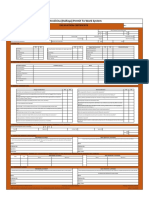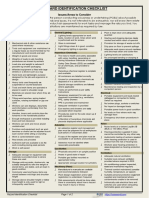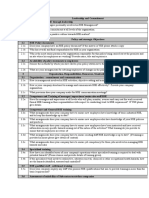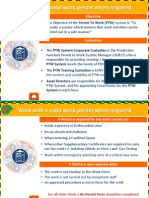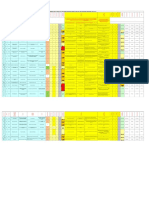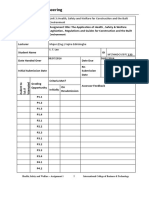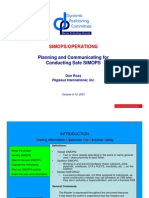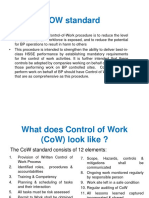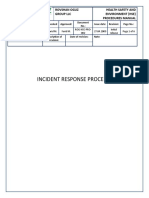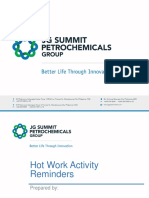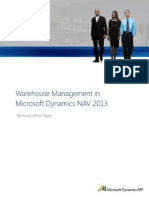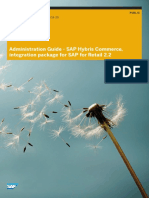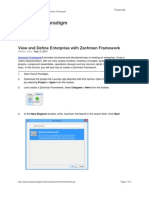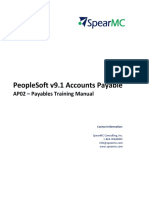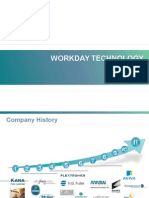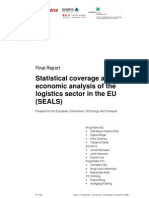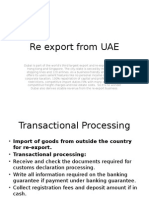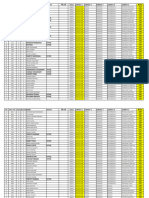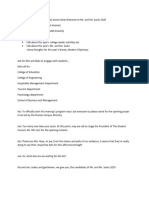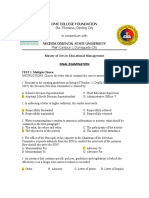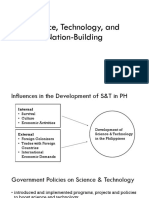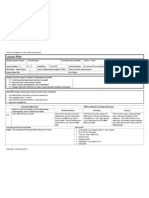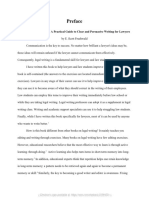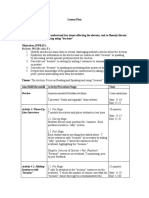Chevron Pipe Line Company Hazard
Analysis Procedure
GUG Version 1.5 [June 2012]
CPL Version 2.0 [effective January 1, 2013]
�CPL Hazard Analysis Procedure
Contents
1.0
Purpose and Objectives ..................................................................................................... 3
1.1
1.2
1.3
1.4
2.0
Scope ................................................................................................................................... 3
Requirements ...................................................................................................................... 3
Terms and Definitions......................................................................................................... 4
Roles, Responsibilities and Training Requirements ........................................................... 4
1.4.1
Initial Training ........................................................................................................ 5
Standard Instructions ......................................................................................................... 5
2.1
Performing a Planning Phase Hazard Analysis ................................................................... 6
2.1.1
Identifying the Task ................................................................................................ 7
2.1.2
Forming the Analysis Team .................................................................................... 7
2.1.3
Breaking-down the Task ......................................................................................... 7
2.1.4
Identifying Potential Hazards .................................................................................. 7
2.1.5
Developing Control Measures................................................................................. 8
2.2 Perform an On-site JSA ...................................................................................................... 8
2.2.1
Introduction ............................................................................................................. 8
2.2.2
Completing an on-site JSA involves the following activities: ................................ 9
2.3 Performing a Personal Hazard Assessment......................................................................... 9
2.4 Monitoring Effectiveness .................................................................................................. 10
2.4.1
Planning Phase HA Document Reviews ............................................................... 10
2.4.2
JSA Document Reviews........................................................................................ 10
2.4.3
JSA Observation Reviews ..................................................................................... 10
3.0
3.1
3.2
4.0
Records............................................................................................................................ 10
Required Records .............................................................................................................. 10
Retention Requirements .................................................................................................... 11
Document Control Information ....................................................................................... 11
4.1
Document Change History ................................................................................................ 11
5.0
Document List ................................................................................................................. 11
Appendix A: CPL Planning Phase Hazard Analysis Worksheet ..................................................... 13
Appendix B: CPL Job Safety Analysis Form .................................................................................. 14
Appendix C: Risk Assessment......................................................................................................... 15
Appendix D: Risk Ranking Matrix (4x4) ........................................................................................ 16
Appendix E: Chevron Hazard Identification Tool ........................................................................... 17
Appendix F: Think Incident Free (TIF) Analysis ............................................................................ 19
Appendix G: On-site JSA Competency Development Model ......................................................... 20
CPL Version 2.0 [effective January 1, 2013]
Printed 14 December 2012. Uncontrolled when printed
cpl_msw_hazard_analysis_procedure_(version 2.0 final).docx
�CPL Hazard Analysis Procedure
Hazard Analysis
1.0
Purpose and Objectives
The purpose of this procedure is to ensure Hazard Analysis is used for the effective
identification, mitigation, control and communication of hazards.
This procedure establishes requirements for hazard analysis. The objective of Hazard
Analysis is to ensure proper consideration is given to the risks associated with completing a
particular task. This procedure follows the three phases of Hazard Analysis, as it applies to
our work; consisting of three specific activities that are recognized as separate, but
complementary components of the Managing Safe Work (MSW) Process:
Planning Phase Hazard Analysis;
Job Safety Analysis (JSA); and the
Personal Hazard Assessment
NOTE: Each upstream and gas strategic business unit (SBU) or location may have additional
regulatory requirements.
1.1
Scope
This Hazard Analysis Procedure covers work performed by Chevron employees and their
delegates and contractors within Chevron Upstream and Gas (U&G) operational control.
Operational Excellence reporting boundary definitions can be found in the OE Data Reporting
Standard. For contractor activities where Chevron does not have operational control, Chevron
will encourage contractors to use hazard analysis tools.
This procedure does not apply to Facilities and Operations HES design reviews, Integrated
Hazard Identifications, or other risk assessment studies as defined in the Corporate OE
Standard Process HES Risk Management.
1.2
Requirements
To comply with this procedure, SBUs will meet the following requirements:
1. A hazard analysis appropriate to the phase of work shall be conducted.
2. A hazard analysis must consider actions as well as physical and environmental conditions.
3. Personnel performing hazard analysis shall be trained and competent in the roles for
which they are responsible.
4. All JSAs must be developed or revised onsite by the personnel performing the work to
ensure the systematic identification and mitigation of site-specific hazards before work
begins.
5. A Job Safety Analysis (JSA) used onsite by an individual work crew shall address
specific tasks.
6. Content of the JSA must be communicated to the work team and other affected parties
immediately prior to beginning work. Communication must occur in a language
appropriate for the work team so that they clearly understand the task hazards, control
measures and actions required to conduct the work safely.
7. Individuals must perform a Personal Hazard Assessment before starting a work task.
CPL Version 2.0 [effective January 1, 2013]
Printed 14 December 2012. Uncontrolled when printed
cpl_msw_hazard_analysis_procedure_(version 2.0 final).docx
�CPL Hazard Analysis Procedure
1.3
Terms and Definitions
The following terms and definitions apply to the Upstream and Gas Hazard Analysis
Procedure:
Chevron Hazard Identification Tool - A tool to help persons while developing or reviewing
a hazard analysis or JSA, or while conducting a Personal Hazard Assessment, to identify
energy sources present in the work environment which may present potential hazards if
released in a an unplanned manner, or contacted in an unwanted way.
Hazard - A condition or action that has the potential for an unplanned release of, or unwanted
contact with, an energy source that may result in harm or injury to people, property or the
environment.
Hazard Analysis - A process used to assess and mitigate risks. It focuses on the relationship
between the worker, the task, the tools, and the work environment.
Operating Procedure (OP) An OP that includes a review equivalent to a hazard analysis
that may be used as the planning phase hazard analysis for work. The OP must meet specific
standards to ensure the required level of hazard and mitigation review has occurred.
Planning Phase Hazard Analysis A hazard analysis usually conducted remotely by project
management and subject matter experts, based on process and operational documentation and
knowledge.
Job Safety Analysis - The JSA is a tool for analyzing a task. This on-site, site-specific,
hazard analysis may be based on a review of planning phase hazard analyses, a Qualified
Standard Operating Procedure (QSOP), or a previously developed JSA for the same task, if
available.
Personal Hazard Assessment - A Personal Hazard Assessment is a self-assessment that
provides an opportunity for the individual worker to focus on a task and ensure they are
prepared to perform it safely. It is typically a reflective exercise undertaken to help each
worker understand his or her responsibility for health and safety.
Risk Assessment - A qualitative or quantitative procedure that evaluates: what can fail or go
wrong; the consequences of each event; the likelihood of each event occurring; and how the
severity and likelihood combine to give an overall statement of risk.
Task - A task is a sequence of steps or activities to complete the work. Tasks are identified
and evaluated to the appropriate level of detail.
Think Incident Free (TIF) A tool that can be used by anyone in the workplace to identify
hazards and unsafe behaviors and then make a plan to performing work without incident.
Four points to consider for working safely are planning, state of mind, training and proper
tools and equipment.
1.4
Roles, Responsibilities and Training Requirements
There must be clearly defined roles, and personnel must meet the training requirements of this
procedure prior to starting work.
The following roles are specific to Hazard Analysis:
Participant/User
Facilitator
A single individual may fulfill more than one role as long as he or she meets the competency
requirements and is able to fully meet multiple responsibilities. When selecting personnel for
CPL Version 2.0 [effective January 1, 2013]
Printed 14 December 2012. Uncontrolled when printed
cpl_msw_hazard_analysis_procedure_(version 2.0 final).docx
�CPL Hazard Analysis Procedure
these positions, consideration should be given to the candidates level of experience and past
performance.
1.4.1 Initial Training
Personnel must meet the initial training requirements of this procedure prior to starting work.
Refer to the U&G Training Requirements Tool.
SBUs are encouraged to adapt standard training material as needed to address local
procedures.
Hazard Identification Tool
Job Safety Analysis (JSA)
Personal Hazard Assessment
A recommended on-site JSA competency development model based on training, field
observations and coaching can be found in Appendix F.
2.0
Standard Instructions
This procedure follows the three phases of hazard analysis as it applies to work. From the
initial planning phase, to the onsite Job Safety Analysis (JSA), to the individual workers
Personal Hazard Assessment. Hazard analysis is critical to identifying potential hazards and
developing actions and strategies to prevent incidents from occurring. Hazard analyses may
also be used as a training tool for new employees, as the basis for health, environment and
safety (HES) checklists, behavior based safety (BBS) observations and safety meeting topics,
and to write HES standards and standard operating procedures (SOPs) for new or modified
jobs. An example of a form for completing the Planning Phase Hazard Analysis, and
subsequently the JSA can be found in Appendix A.
Table 1.
Summary of Hazard Analysis Methods
Analysis
Method
When to use
Intent
Format
Planning Phase
Hazard Analysis
(e.g. Risk
Assessment, Job
Hazard
Analysis,
Safety Plan,
Safety
Instruction,
QSOP)
During the
planning phase of
work: pre-work,
project planning,
design reviews,
execution plan
development
The format must be consistent
with the level of risk posed by
the task, as determined by the
SBU. For low-risk work, could
be an unwritten review of a
generic (library) safety plan,
QSOP, operator checklist, or
other form of hazard analysis;
for all other work, must be a
documented hazard analysis as
described in the standard
instructions.
Job Safety
Analysis (JSA)
During the onsite
preparation/
permitting/executi
on phase of work:
To identify anticipated
hazards and plan
mitigations
To ensure that the right
number of people, skill
sets, equipment and PPE
are included in the plan
To identify the types of
permits required to do the
work
To identify the SWP
standards and SOPs
applicable to the work
For use as starting point
for onsite JSA
To involve the work team
to make sure that the
people doing the work
understand the tasks,
CPL Version 2.0 [effective January 1, 2013]
Printed 14 December 2012. Uncontrolled when printed
cpl_msw_hazard_analysis_procedure_(version 2.0 final).docx
Typically a formal written JSA
meeting the elements of the
standard instructions, for work
not clearly identified by the SBU
5
�CPL Hazard Analysis Procedure
Analysis
Method
Personal Hazard
Assessment
(e.g. Think
Incident-Free
(TIF), Personal
Safety Plan,
Stop, Think,
Go)
2.1
When to use
Intent
Format
prior to start of
work
hazards and mitigations
To address onsite
conditions on the day of
the work
To identify mitigation
measures, and assign
responsible to verify they
are in place
To verify that work team
has proper skill level and
tools to complete the job
safely
To prompt workers to
think before they act
To ensure that the worker
is looking for hazards
while they are doing
work
To support Stop Work
Authority and the Tenets
of Operation
as low-risk. For low-risk work,
may be an unwritten JSA, job
site discussion, or a Personal
Hazard Assessment, as
determined by the SBU.
Anytime,
including during
the course of
performing the
work
This is typically an unwritten
self-assessment done as a
reflective mental exercise by
each worker immediately prior
to beginning his or her specific
activities. For low risk work, this
may be the only hazard analysis
conducted.
Performing a Planning Phase Hazard Analysis
A planning phase hazard analysis involves the following activities:
Identifying the task
Forming the team (for simple tasks, this may be one person)
Breaking down the task into steps
Identifying potential hazards
Developing control measures to mitigate the identified hazards
Conducting risk ranking (Optional)
Note: Information on conducting a Risk Assessment can be found in Appendix B.
CPL Blue Text
A written Planning Phase Hazard Analysis is required for project related work, where there
is a work owner (e.g. Project Manager, Engineer, Construction Representative, Project
Coordinator) and when the work activity and work tasks are associated with Safe Work
Practices (Confined Space, Excavation, Isolation of Hazardous Energy, Hot Work, Electrical,
Lifting and Rigging, Working at Heights, and Bypassing Critical Protections).
For project work managed and performed by CPL, the CPL - Planning Phase Hazard
Analysis must be used to document the analysis.
For project work managed and performed by Contractors, the Contractor Job Safety Plan
(CJSP) (formerly Job Site Safety Plan (JSSP)) must be used to document the analysis.
For non-project work, the work planning activities performed by a competent Person in
Charge are considered to be the Planning Phase Hazard Analysis. These activities include,
6
CPL Version 2.0 [effective January 1, 2013]
Printed 14 December 2012. Uncontrolled when printed
cpl_msw_hazard_analysis_procedure_(version 2.0 final).docx
�CPL Hazard Analysis Procedure
but are not limited to the review of relevant CPL Safe Work Practices, Maintenance and
Inspection Procedures, and other relevant safety procedures.
2.1.1 Identifying the Task
A task is a sequence of steps or activities to complete the work. Tasks are identified and
evaluated to the appropriate level of detail. Drilling a well or performing a shutdown on a
gas plant is too broad to be a single task, and tasks such as turning on a switch are too
narrow for effective analysis. The appropriate level of detail for a task is typically the type of
assignments that a supervisor would make (e.g., removing a pump for maintenance, collecting
an oil sample from a vessel, or installing a blind in piping).
In the planning phase for a large scope of work (e.g., capital project), the hazard analysis may
consist of a single assessment covering many tasks.
2.1.2 Forming the Analysis Team
Person(s) performing the analysis should:
Be experienced and knowledgeable about the task and hazards
Understand the hazard analysis procedure
Be an experienced facilitator, if appropriate
When forming the team, consider factors such as the complexity of the task, the location of
the work and the size of the workgroup. In addition to the person doing the job, team
members should be selected as appropriate and may include other workers, supervisors and
HES professionals. If the hazard analysis is being prepared for a task that will require a
permit, the team should include participation by the Area Controller (a.k.a. Person in Charge)
and Work Team Leader (a.k.a. Person Conducting the Workge) who will be involved in the
permitting. In some cases, it may be acceptable for an analysis to be prepared by one person.
The planning phase hazard analysis may be initiated in an office setting, and be based
primarily on facility and process knowledge and documentation reviews; however,
information obtained from site visits by the person conducting the hazard analysis may
provide a more complete analysis.
2.1.3 Breaking-down the Task
Before the search for potential hazards begins, the task is broken down into a sequence of
events consisting of the major steps, with each step describing what is being done. Begin by
asking, What step starts the task? then, What is the next basic step? and so on. If too
many steps result from the analysis (over 15), consider breaking that job into more than one
task.
When beginning to document the analysis, describe and number each step on the analysis
form. Each step tells what is done, not how. The description for each step should begin with
an action word such as remove, climb, open or weld. The description of the step is
completed by naming the item to which the action applies, for example, remove
extinguisher, or carry to fire.
Check the breakdown of the steps with other team members, particularly someone who is
knowledgeable about performing the task. Obtain agreement on the description of what is
done and the order of the steps.
2.1.4 Identifying Potential Hazards
Once the basic steps have been determined, begin the search for potential and existing
hazards.
CPL Version 2.0 [effective January 1, 2013]
Printed 14 December 2012. Uncontrolled when printed
cpl_msw_hazard_analysis_procedure_(version 2.0 final).docx
�CPL Hazard Analysis Procedure
Look at physical conditions (chemicals, tools, work space, etc.), environmental factors (heat,
cold, noise, lighting, weather conditions, etc.) and actions or behaviors (need to stand on a
slippery or unstable surface, extended reach to operate a valve, lifting bulky objects).
Additional information on increasing hazard identification skills is located in the MSW
Support Materials.
An example of identifying hazards using the Chevron Hazard Identification Tool can be
found incorporated into the form in Appendix A.
2.1.5 Developing Control Measures
The next step in a hazard analysis is to identify control measures, which exist, or should be
put in place, in order to eliminate potential hazards, or mitigate them to an acceptable level of
risk. Identifying control measures for each hazard, even those already controlled will facilitate
understanding and communication. The principal control measures detailed below represent a
hierarchy (order of preference) in which they should be considered:
Determine if the work is necessary - eliminate unnecessary work that adds risk and does
not contribute to achieving the desired result.
Change the physical conditions that create the hazards change in tools, materials,
equipment, layout or location. This is the preferred approach until there is general
agreement that work conditions are as safe as reasonably practical.
Change the work procedure ask, What should the employee do, or not do, to eliminate
this particular hazard or prevent this potential accident? The answer might be as simple
as standing to the side when opening the valve, or getting a good stance before lifting an
item.
Add barriers between the hazard and the receptors fire blankets, warning tape, personal
protective equipment (PPE), etc.
Find a completely new way to do the job if the above steps have not yielded a safe,
efficient way to perform the task, and then look at the task itself. Determine the goal of
the job and analyze alternative ways of reaching this goal.
Control measures should be stated so that people clearly understand what to do. There is
usually not enough space on the assessment form to explain how to do it. The needed level of
detail should be included in procedures, manuals, employee training, or in some other form so
that everyone understands how to do the task safely.
NOTE: Identifying associated procedures (when/ where applicable) is a viable mitigation
when incorporated by review and thorough understanding of individuals involved in job task
planning.
2.2
Perform an On-site JSA
2.2.1 Introduction
The Job Safety Analysis (JSA) is the final part of analyzing a task prior to starting job. This
analysis occurs at the work site prior to work beginning, and involves those individuals doing
the work and communication with those that may be affected. The JSA is performed because
the planning phase hazard analysis may not always identify onsite or working environment
hazards, as they may not always be apparent or realized during the planning process. For
example:
Other activities in the same location may require additional controls related to
communication or safety barriers
CPL Version 2.0 [effective January 1, 2013]
Printed 14 December 2012. Uncontrolled when printed
cpl_msw_hazard_analysis_procedure_(version 2.0 final).docx
�CPL Hazard Analysis Procedure
Environmental factors e.g. wind speed and direction may have an additional impact on the
work
Technical aspects of the job may introduce additional hazards that require onsite changes
to be considered. These additional hazards should be assessed using the same method as
previously used in the planning phase hazard analysis process
Other affected and/or knowledgeable persons may identify additional hazards
2.2.2 Completing an on-site JSA involves the following activities:
For work determined to be low-risk, workers may use an unwritten hazard analysis,
Personal Hazard Assessment, job site discussion, or other undocumented hazard analysis
method.
For work not determined to be low-risk, completion of a written JSA form with the
following elements:
Title and summary description of the task(s) to be performed
The Name of the person leading the work, the work location, permit #(s) and date
A list of the steps required to accomplish the task(s)
A list of potential hazards associated with each step
A list of controls or mitigations for each potential hazard
Acknowledgement of understanding by each member of the work team through
signature on the form
A risk assessment for each step (optional)
Note: Information on conducting a Risk Assessment can be found in Appendix B.
Conducting an Onsite Briefing/Toolbox Talk prior to commencing the work, to ensure
that the work team is aware of the hazards and control requirements. The onsite pre-job
briefing should be carried out by the Work Team Leader and include the following:
Conducting additional reviews if:
2.3
Reviewing the JSA with the work team and other potentially affected persons
Assessing any additional hazards at the worksite
Ensure the appropriate control measures are in place
Assign responsibility to ensure control measures are in place
Emphasize the use of Stop Work Authority (SWA), and identify and discuss
examples of actions or conditions which might lead to use of SWA during this job
Confirm work-party understanding
Obtain the signatures of all the work-party on the JSA documentation
Job scope changes significantly
New personnel are added to the work party
Site conditions change beyond those originally identified
A near miss, incident, or other work stoppage occurs
A concern is raised as the result of a Personal Hazard Assessment
Following the work, reviewing the activity and agreeing lessons learned for continual
improvement;
Document lessons learned and update planning phase hazard analyses, SOPs, etc. for
future use.
Performing a Personal Hazard Assessment
Each individual should perform a Personal Hazard Assessment prior to beginning work tasks,
and regularly reassess the work environment. Personal Hazard Assessments encourage
CPL Version 2.0 [effective January 1, 2013]
Printed 14 December 2012. Uncontrolled when printed
cpl_msw_hazard_analysis_procedure_(version 2.0 final).docx
�CPL Hazard Analysis Procedure
individual employees to reflect on, and take ownership of identifying and ensuring controls
are in place for the hazards to which they may be exposed.
The minimum steps of an effective Personal Hazard Assessment are:
Understanding the method to perform the task safely
Determining the potential hazards
Determining what can be done to eliminate the hazard
Acting to prevent any negative consequences
SBUs may use a variety of tools to support their Personal Hazard Assessments.
Appendix E contains an example of a Personal Hazard Assessment using the Think Incident
Free (TIF) tool.
2.4
Monitoring Effectiveness
2.4.1 Planning Phase HA Document Reviews
Planning Phase Hazard Analyses often form the basis for subsequent on-site JSAs, as well as
the hazard analyses incorporated into QSOPs, therefore, SBUs should consider assigning
responsibility to validate they are prepared correctly, this procedure is followed, and that the
results are clearly communicated to stakeholders.
A potential option designed to help ensure these hazard analyses are completed effectively
can be found in the example Hazard Analysis Team Charter.
These HA document reviews should be initiated and completed as defined in the SBU
verification matrix. HA reviews should be documented and submitted to the SBU designated
location, for review by the SBU Process Sponsor and Advisor or designee.
2.4.2 JSA Document Reviews
JSA document reviews will be used periodically (as determined by the SBU) by Supervisors
and the MSW Process Sponsor/Advisor to provide evidence of consistency in developing
effective JSAs. Note: The onsite JSA documents are only one aspect of the JSA process, and
these reviews may not provide insight into the communication of the JSA or any pre-job
briefings/discussions that may have been conducted. Results of the document reviews should
be regularly communicated to the workforce to provide for continuous improvement.
2.4.3 JSA Observation Reviews
As part of the recommended competency development activity, regular reviews of the
findings of JSA field observations should be performed and communicated to Supervisors and
the MSW Process Sponsor/Advisor to provide evidence of consistency and effectiveness of
communication of JSAs. Results of the observation reviews should be communicated to the
workforce.
3.0
Records
3.1
Required Records
The following records will be kept:
10
Copies of Planning Phase Hazard Analyses, JSAs and other associated documentation
should be maintained as defined by the SBU.
CPL Version 2.0 [effective January 1, 2013]
Printed 14 December 2012. Uncontrolled when printed
cpl_msw_hazard_analysis_procedure_(version 2.0 final).docx
�CPL Hazard Analysis Procedure
3.2
Retention Requirements
In order to facilitate the review process and improve the quality of assessments, hazard
analyses should be retained at an SBU designated location for one year or as otherwise
defined by the SBU.
CPL Blue Text
CPL record retention requirements will be a minimum of 2 years.
4.0
Document Control Information
Table 2.
Document Control
Description
U&G Common
Approval Date
01 October 2011
Next Approval Due
February 2012
SBU Specific
Control Number
4.1
Document Change History
Changes to this document are listed in the table below in reverse order by change date.
Table 3.
Document Change History
Date
Revision
Number
Description of Change
27 February 2008
1.0
Initial release of Global Upstream process
30 May 2008
1.1
Add link to hazard Analysis Risk Matrix
8 December 2008
1.2
Added bookmarks for OE Mentor
01 October 2011
1.3
Added language clarification and made formatting
changes
11 November 2011
1.4
Updated to new U&G template
01 June 2012
1.5
Updated to include Corporate Required MSW Process
Requirements
5.0
Document List
This is a complete list of the documents referenced in this process.
Table 4.
Document List
Procedure/Attachment Title
File Name
OE Data Reporting Standard
U&G Training Requirements Tool
OE Data Reporting Standard
UG_MSW_TrainingRequirementsTool.doc
U&G MSW SWA Procedure
UG_MSW_StopworkAuthorityProcedure.doc
CPL Version 2.0 [effective January 1, 2013]
Printed 14 December 2012. Uncontrolled when printed
cpl_msw_hazard_analysis_procedure_(version 2.0 final).docx
11
�CPL Hazard Analysis Procedure
Procedure/Attachment Title
File Name
Example Hazard Analysis Team
Charter
Hazard Analysis Team Charter.
MSW Process Flow Diagram
MSW Process Flow Diagram
Hazard Identification Tool
Hazard Identification Tool
12
CPL Version 2.0 [effective January 1, 2013]
Printed 14 December 2012. Uncontrolled when printed
cpl_msw_hazard_analysis_procedure_(version 2.0 final).docx
�Appendix A: CPL Planning Phase Hazard Analysis Worksheet
CPL Version 2.0 [effective January 1, 2013}
Printed 14 December 2012. Uncontrolled when printed.
cpl_msw_hazard_analysis_procedure_ (version 2.0 final 12-7-12).docx
13
�Appendix B: CPL Job Safety Analysis Form
14
CPL Version 2.0 [effective January 1, 2012]
Printed 14 December 2012. Uncontrolled when printed
cpl_msw_hazard_analysis_procedure_ (version 2.0 final 12-7-12).docx
�Appendix C: Risk Assessment
An additional step that may be included in a hazard analysis is an assessment of the risk associated
with each job step. Control measures are intended to either eliminate the risk of the job (task) or
reduce it to an acceptable level. Using an approved Risk Matrix as shown on the next page, each
hazard identified in a planning phase hazard analysis or in a JSA is assessed for the risk before any
control measures are applied.
Once the control measures are applied, the Risk Matrix is used to determine the potential severity
and the likelihood of the risk for each step in the job, which leads to a residual risk ranking code of
Low, Medium or High (L, M, and H). The consequence effect from a hazard does not normally
change through the implementation of a control, only the likelihood of the consequence occurring.
Where residual risk is determined to be acceptable and as low as reasonably practicable, the work
may continue based on agreement from the hazard analysis team. If the residual risk is too high
then the work should be scheduled for an alternate time when the risk can be adequately controlled.
CPL Version 2.0 [effective January 1, 2013]
Printed 14 December 2012. Uncontrolled when printed.
cpl_msw_hazard_analysis_procedure_ (version 2.0 final 12-7-12).docx
15
�Appendix D: Risk Ranking Matrix (4x4)
16
CPL Version 2.0 [effective January 1, 2013]
Printed 14 December 2012. Uncontrolled when printed
cpl_msw_hazard_analysis_procedure_(version 2.0 final).docx
�Appendix E: Chevron Hazard Identification Tool
Hazard identification tools provide a structured approach for identifying hazards and may provide
assistance when creating a hazard analysis.
The Chevron Hazard Identification Tool is based on first identifying energy sources in the workplace,
which if contacted in an unwanted way or released in an unplanned manner can pose a hazard. Look
at physical conditions (chemicals, tools, stored pressure, elevation, etc.), environmental factors (heat,
cold, noise, lighting, wet conditions, etc.) and actions or behaviors (equipment or personnel
movement, etc.). Identify all energy sources associated with each step regardless of the level of
control present, and then identify potential hazards based on unwanted contact or an unplanned
release of energy.
CPL Version 2.0 [effective January 1, 2013]
Printed 14 December 2012. Uncontrolled when printed.
cpl_msw_hazard_analysis_procedure_ (version 2.0 final 12-7-12).docx
17
�18
September 2011. Revision 1.4.
Printed 14 December 2012. Uncontrolled when printed
cpl_msw_hazard_analysis_procedure_ (version 2.0 final 12-7-12).docx
Company Confidential
�Appendix F: Think Incident Free (TIF) Analysis
CPL Version 2.0 [effective January 1, 2013]
Printed 14 December 2012. Uncontrolled when printed.
cpl_msw_hazard_analysis_procedure_ (version 2.0 final 12-7-12).docx
19
�Appendix G: On-site JSA Competency Development Model
Through various lagging metric analyses, inadequate JSAs continue to be seen across U&G as a
significant issue. The following information is provided in order to specifically address opportunities
to improve the quality of on-site JSAs.
While training on the development and documentation of an on-site JSA is currently provided in the
SBUs, there is an opportunity to go beyond training to develop competency on JSA development and
delivery. Competency not only involves training on how to complete a JSA, but also requires practical
knowledge of the tasks and hazards. In addition, a demonstration of understanding of the hazard
analysis procedure and the ability to communicate with diverse work teams is also critical.
Definitions
Competencies define the applied knowledge, skills and behaviors that enable people to
successfully perform their work.
Knowledge is the information that allows a person to perform from an informed perspective.
Skills are demonstrated abilities or proficiencies (e.g., Identification of Tasks at appropriate level
of detail, Hazard Identification, etc.)
Behaviors are the manner of conducting oneself, the response of an individual to his/her
environment (e.g., Communicates Clearly, Fosters Collaborative Relationships, etc.)
Development Plan
Competency is developed in stages, and while sometimes advantageous, not all personnel involved in
the JSA process require the same level of competency. A summary of competency levels is provided
in Table 1.
NOTE: All personnel should be able reach the Basic Application level, and be seen as active
participants in the on-site JSA process.
Table 1. Competency Level Summary
Competency Level
Description
Source
Awareness
A basic conceptual
understanding of a JSA
Overview presentation, general
knowledge
Knowledgeable
Understanding of the need
for a JSA, the steps required
to complete a JSA, the task to
be performed, the typical
hazards and controls
associated with the task, and
the Hazard Identification
Tool
Learning activities:
Web-based training
Instructor-led/classroom
coursework
Field discussions
Basic Application
Demonstrated understanding
of JSA process
Participation in field activities as a
member of a team
Demonstrated
Comprehension
Demonstrate the ability to
materially participate in
development of a JSA
Observation and mentoring by work
team leader who leads development
and communication of JSA
Skilled Application
Leading development (acting
as a facilitator) of JSAs, and
demonstrating ability to
communicate with and
engage all members of work
Observation and coaching by
competent personnel from outside
the work team, of leader of JSA
development
20
CPL Version 2.0 [effective January 1, 2013]
Printed 14 December 2012. Uncontrolled when printed
cpl_msw_hazard_analysis_procedure_(version 2.0 final).docx
�team
Analysis and Evaluation
Able to evaluate
documentation for quality,
conduct observations on
peers and provide coaching
to improve the process
The prize! If we can get a sufficient
critical mass of personnel to this
level, the process will be improved.
In order to identify personnel capable of progressing to a higher level of competency, observations
can be used to determine who either based on current ability or through mentoring and coaching, has
the ability for further development.
CPL Version 2.0 [effective January 1, 2013]
Printed 14 December 2012. Uncontrolled when printed.
cpl_msw_hazard_analysis_procedure_ (version 2.0 final 12-7-12).docx
21
�Field Observation and Coaching Guide
Planning To identify what to observe, consider the following:
Type of Job
What scheduled jobs relate to
identified risks for your operations?
Is there unscheduled work that
warrants observation?
Is there scheduled work by non-core
contractors to observe?
Is there routine work planned that has
recently resulted in an incident or near
miss?
Is there routine work that has not been
recently observed based on your
defined schedule?
Equipment Involved
Do any jobs involve tools or equipment
linked to previous incidents (e.g.,
cranes, man-lift, back-hoe, etc.)?
Does the job require isolation of
equipment or energy sources?
Does the job require bypassing critical
protections?
Characteristics of Workers
Is there an employee, or contractor crew
you have not observed?
Is there a crew you want to follow-up
from a previous observation?
Are there any SSEs working?
Is there a worker or crew that hasnt
worked here recently?
Is there a worker or crew with a history
of previous incidents?
Situations
Is work being done in a new
location?
Is work near a highly populated
area?
Can the work be affected by
adverse weather conditions?
Does the work involve a new or
revised SOP or standard?
Are there multiple workgroups
involved?
Is Chevron supervision for the work
area new to the role?
Planning Before Going Out Consider the following:
Do you need SME input about the job you plan to
observe?
What key job steps or hazards relate to this work?
Are there procedures you could review in advance?
Do you have a defined scope of work or work order
documentation?
22
What information do you need about the crew you will
observe?
Whats the crews safety record?
Is this a regular crew or one that works for multiple
companies?
Is anyone on the crew just back from vacation? Sick
leave?
Is there anyone on the crew who has a record of safety
violations?
Confirm the job start time
Determine of you want to be there at the
beginning or after the job starts?
Make sure you have a phone number (e.g.,
Permit Approver, Field Specialist, Maintenance
Planner, contractor supervisor) so you can locate
crew if needed.
September 2011. Revision 1.4.
Printed 14 December 2012. Uncontrolled when printed
cpl_msw_hazard_analysis_procedure_(version 2.0 final).docx
�Assess QUALITY of Pre-Job Safety Planning
Get Oriented to the Job
At job site with the Person
Leading Work
Do they know what to do?
See the big picture?
Crew experience with
this task?
o How often?
o Last time?
o Training?
o Experience with this
equipment?
o SSEs?
Crew make-up?
First language?
Crew experience with
this SBU?
Crew experience with
this CVX?
Summary:
Right scope?
Right tasks?
Right people?
Right timeframe?
Confirm the Major
Job Steps
Identify the Hazards
Identify Their
Mitigation Plan
At job site with full crew, but ask random individuals
Do they know how to
do it?
Get them to point out
the major steps
(visualize)
o Your
understanding of
the steps for this
job?
o Who is doing
what?
o Your role on this
step?
o How does the work
of others affect
your work?
o Right tools &
equipment in
place?
If the job is already in
progress, ask:
o What step are you
working on now?
How long will the job
take?
Using written
procedures?
o If so, which ones?
How they can get hurt
doing it?
Their most critical
hazards?
Test against random
job Steps
Pinpointed?
Other hazards not
mentioned?
Other hazards with
tools & equipment?
Sample Questions
Most hazardous part
of this job?
Of any specific step?
Hazards seen before
on jobs like this?
What tools did you
use to help identify
hazards (e.g., Hazard
Wheel, TIF card,
etc.)? How did you
use this tool?
What did you find?
Do they know how to
keep safe?
Mitigation plans for
hazards?
o Cookie cutter vs.
specific?
o PPE needed for this
task?
o When mitigation
will be done?
o How?
Communication strategy
for hazards,
mitigations?
Review Their JSA
Observe Their Work
At job site with the
Person Leading Work
At job site
At job site
Are they following
their pre-job safety
plan?
Are they performing
steps based on
preplanning?
Are they mitigating
the hazards as
necessary?
Are their mitigation
actions preventing
or controlling the
hazard?
Are other risks or
unidentified hazards
occurring?
Do you note scope
or conditions
changes?
o If so, do they
discuss it?
o Do they update
the JSA?
Use a positive
feedback model:
Find something
positive theyve done
and give them
feedback
Ask crew what they
would do differently
(i.e., how to make it
safer next time
Pinpoint 1 or 2 big
things to work on
(i.e., whats the
takeaway?)
Thank the crew for
taking time away
from their job to talk
with you about safety
Did they write it
down?
Is JSA consistent
with dialogue?
o Validate scope
o Did the work
order scope the
job properly?
o Job steps need to
be added?
o Right number of
crew?
o Right tools &
equipment?
o Right sequencing
with other crews?
o JSA reflects
changes in scope
beyond work
order?
Provide feedback on
thoroughness of JSA
o Correct
inconsistencies on
form or discuss
with crew
Provide Feedback to
Whole Crew
Document Observation Immediately after the Observation
Complete the observation form in private
Note technical safety issues you need to know more
about
Note any action items
What feedback from the form needs to be shared
with the:
Permit Approver
Person Leading Work or Contractor Supervision
CPL Version 2.0 [effective January 1, 2013}
Printed 14 December 2012. Uncontrolled when printed.
cpl_msw_hazard_analysis_procedure_(version 2.0 final).docx
Submit observation form for review/analysis per SBU
plan
23
�Observations of on-site JSA
Observation of the on-site JSA process is time-consuming, and should only be conducted by individuals with
demonstrated competency (e.g. SME, experienced HES personnel, etc.). Therefore, this process requires a
significant commitment of resources to be successful.
Observations should be performed consistently, using a standardized form to focus observers on JSA
development and execution. The following elements are critical to a successful observation:
Identify specific jobs to be observed (high-risk, non-routine, incident history, etc.)
Gather background information
Schedule to observation with the work team
Establish a relationship with the Supervisor and work team
Get oriented to the job
Confirm the major job steps
Identify the hazards
Identify the mitigations/controls
Review the JSA form
Observe the pre-job meeting and communication
Observe the work
Provide feedback to the supervisor and work team
Document the observation
An example of an observation form can be found on the following pages.
24
Printed 14 December 2012. Uncontrolled when printed
cpl_msw_hazard_analysis_procedure_(version 2.0 final).docx
�U&G Hazard Analysis Procedure
Current SBU Risk List
Risks & Key Behaviors
Yes
No
Safety Observation FormRevision 4.27/12/10
Comments (If No, record why)
Risk:
General Information
Observer:
Observation Date:
Duration of Observation:
Risk:
Site Location: Plant
Field
Who is working?
Contractor:
Crew Pusher:
Permit Approver:
CVX Employees
Work Task Being Observed:
Names of SSEs Present :
Target Hazard(s):
Permitted Job?
N
Name of Mentor Assigned:
Number of people observed:
Part 1: Quality of Pre-Job Safety Planning (How well did the crew prepare
before starting the work?)
Based on your DIALOGUE with the Based on your REVIEW OF THE
work crew:
JSA document:
If a No, explain the GAPS:
If a No, explain the GAPS:
Risk:
1. Steps
Identified
?
Y Missing:
N
2. Hazards
identified
(for steps
identified)
?
Y Missing:
N
Risk:
Too general
Not in sequence
Other:
Missing:
Too general
Not in sequence
Other:
Y
N
Too general
Not in sequence
Other:
3. Mitigation Y Missing:
identified N Too general
(for
Not in sequence
hazards
Other:
identified)
CPL Version 2.0 [effective January 1, 2013}
Printed 14 December 2012. Uncontrolled when printed.
cpl_msw_hazard_analysis_procedure_ (version 2.0 final 12-7-12).docx
Y
N
Missing:
Too general
Not in sequence
Other:
Y
N
Missing:
Too general
Not in sequence
Other:
25
�U&G Hazard Analysis Procedure
Part 1: (CONTD.)
4. Additio
nal
Dialogue with
random crew
members
confirmed
shared
understanding of
the steps,
hazards &
mitigations (i.e.,
consistency in
responses)
JSA covered wrong
job
JSA was not written
JSA written but not
available
Canned JSA missing
site-/job-specific
information
JSA covered too much
work
Job inadequately
scoped
Crew began work
before writing JSA
Steps, hazards &
mitigations not
correlated
Crew member
signature missing on
JSA
Other:
Part 2: Adherence to Pre-Job Safety Planning
(How well is the crew following their safety planning during the work?)
What job
step(s) did
you
observe?
Did they
perform
this step
based on
their preplanning?
Did they
mitigate
the
anticipate
d hazard
effectively
?
Did
unplanned
hazards
occur?
Did they
mitigate
the
unplanned
hazard?
Y or N
Y or N
Y or N
Y or N
Part 3: Ensure Update of Pre-Job Planning When Scope or Conditions
Change
Y N Did scope or conditions change during or before your observation? If yes:
Y N Did the crew(s) modify the written JSA form appropriately before you
coached or questioned them?
Y N Did the crew(s) discuss the changes? (Steps, Hazards, Mitigations)
Part 4: Additional Questions Regarding the Crew or a Crew Member
Wasnt focused on the job (state of mind)
Lacked knowledge or skill related to the job
task or correct use of tools/equipment
(training)
Missing necessary tools or equipment for this
job
Unfamiliar with or not following procedures
related to this job
Had to use SWA
Did not use the Hazard ID Wheel in their
pre-job safety planning
Roles and responsibilities werent clear
Failed to communicate appropriately with
each other or with other crews also working
Part 5: Follow Up for Observer
1. What good ideas or Best Practices emerged from this observation?
Categories to check:
2.
Missed hazard:
Missed mitigation:
Missed hazard:
Missed mitigation:
Did you/will you provide feedback to the Permit Approver? Y N
R+:
:
3. What feedback needs to be shared with contractor company?
Categories to check:
4. What action items do leaders need to take, based on this observation?
Categories to check:
Missed hazard:
5.
Have you observed this Crew Pusher before? Y N
If Y, are the behaviors you coached on previously performed correctly now? Y N
Missed mitigation:
6.
What talking points can you share at a morning meeting?
CPL Version 2.0 [effective January 1, 2013}
Printed 14 December 2012. Uncontrolled when printed.
cpl_msw_hazard_analysis_procedure_(version 2.0 final).docx
(Notation, not for database.)
26















